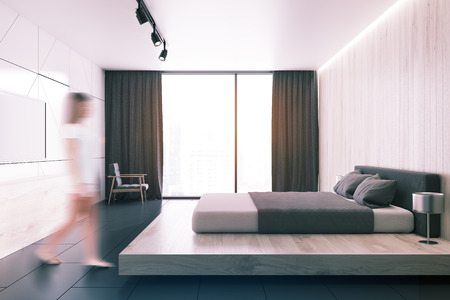Understanding Minimalist Feng Shui
Feng Shui is an ancient Chinese art that focuses on arranging your living spaces to promote balance, energy flow, and harmony. Its origins date back thousands of years, with a central belief that the environment around us can deeply affect our well-being. In modern times, especially in American homes, this traditional practice finds a perfect partner in minimalist design. Minimalism—often summed up as “less is more”—emphasizes simplicity, functionality, and the beauty of uncluttered spaces.
The Roots of Feng Shui
At its core, Feng Shui is all about creating positive energy (known as “chi”) by thoughtfully organizing furniture, decor, and even color choices. Here’s how some of its main principles blend with minimalism:
| Feng Shui Principle | Minimalist Design Element | How They Work Together |
|---|---|---|
| Clear Pathways for Energy Flow | Open Spaces | No crowded furniture; easy movement around the home enhances comfort and calm. |
| Decluttering for Harmony | Less is More | Keeping only what you need reduces stress and creates a peaceful atmosphere. |
| Balance of Elements (wood, fire, earth, metal, water) | Neutral Palettes & Natural Materials | Simple colors and textures highlight nature-inspired decor without overwhelming the space. |
| Intentional Placement of Objects | Functional Design | Every item has a purpose; nothing feels out of place or excessive. |
The Power of Simplicity at Home
In today’s busy world, American homeowners are drawn to both Feng Shui and minimalism for their ability to make life feel lighter and more organized. A streamlined home isn’t just visually appealing—it’s also emotionally comforting. By focusing on fewer possessions and more meaningful arrangements, you naturally encourage better energy flow. The result? Rooms that feel open, inviting, and harmonious without sacrificing style or comfort.
Why Less Can Be More: Key Benefits
- Easier Cleaning: Fewer items mean less dusting and tidying up.
- Mental Clarity: An uncluttered environment leads to clearer thinking and reduced anxiety.
- More Space: Open floor plans make rooms feel bigger and brighter.
- Sustainable Choices: Buying less encourages mindful consumption—a value shared by many Americans today.
Bringing It All Together
The harmony between minimalist design and Feng Shui principles creates a modern sanctuary where every detail counts. Whether you live in a cozy city apartment or a spacious suburban house, embracing these ideas helps transform your space into a true retreat—one that supports your lifestyle and uplifts your spirit every day.
2. The Modern Chi: Energy Flow in American Homes
Understanding Chi in a Minimalist Context
In Feng Shui, “Chi” (pronounced “chee”) means the flow of energy that moves through your home. In minimalist Feng Shui, the goal is to let this energy move freely and naturally, creating a calm, balanced atmosphere. For many American homes, which often feature open floor plans, casual living spaces, and multi-purpose rooms, arranging for good Chi flow is both practical and achievable.
Common American Home Layouts and Chi Flow Challenges
Each type of home layout comes with its own unique Feng Shui considerations. Here’s a quick guide to some common layouts:
| Layout Type | Chi Flow Challenge | Minimalist Feng Shui Tip |
|---|---|---|
| Open Concept Living Room/Kitchen | Energy can feel scattered or chaotic | Use rugs or furniture to define zones; keep pathways clear for easy movement. |
| Hallway-Centered Layout | Chi may rush too quickly through halls | Add artwork or soft lighting to slow down the energy and make halls inviting. |
| Multi-Use Spaces (e.g., office/guest room) | Difficult to maintain focus or relaxation | Choose flexible furniture and use storage solutions to keep clutter out of sight. |
| Larger Suburban Homes | Unused rooms can create stagnant energy spots | Repurpose underused spaces, even with simple décor or plants to keep energy moving. |
| Apartments/Condos | Limited space; entryways open directly into living areas | Create a welcoming entry point with a small rug, mirror, or plant near the door. |
Practical Tips for Arranging Your Space
- Edit and Simplify: Only keep what you love and need. Less clutter means smoother energy flow and a more peaceful mind.
- Open Pathways: Make sure you can walk easily from room to room without bumping into furniture or piles of stuff. Wide, clear pathways help Chi circulate.
- Balanced Lighting: Use a mix of natural light and lamps. Bright spaces invite positive energy; dark corners can trap negativity.
- Smooth Edges: When possible, choose furniture with rounded edges instead of sharp corners to soften the flow of Chi.
- Nourishing Nature: Add simple touches like a potted plant or fresh flowers to bring life into your space.
- Sensible Storage: Use baskets, bins, or built-in shelves to hide away everyday clutter while keeping essentials handy.
- Main Entry Focus: Keep your front door area tidy and welcoming; it’s the main entrance for energy (and guests) into your home.
Sample Minimalist Feng Shui Room Arrangement
| Room | Main Focus | Simplified Feng Shui Action |
|---|---|---|
| Living Room | Create conversation and comfort zones | Sofa facing the door but not directly in line; coffee table with rounded edges; one piece of art on the wall. |
| Bedroom | Restful sleep environment | No electronics; bed with solid headboard against a wall; two small nightstands for symmetry. |
| Kitchen/Dining Area | Nourishment and gathering space | Counters clear of excess items; one bowl of fresh fruit on the table; chairs tucked in after meals. |
| Home Office Nook | Mental clarity and focus | Laptop stored when not in use; only essential supplies on desk; small plant nearby. |
Your Modern Harmony Awaits
Tweaking just a few things in your American home—whether it’s an apartment in the city or a house in the suburbs—can make a big difference in how positive energy flows. Remember: Minimalist Feng Shui isn’t about strict rules but about adapting ancient wisdom to fit your modern lifestyle.
![]()
3. Decluttering for Mindful Living
Decluttering is at the heart of minimalist Feng Shui and serves as the foundation for a peaceful and harmonious home. By clearing away unnecessary items, you open up your space to positive energy (or “chi”), inviting clarity and calm into your daily life. Here’s how you can master intentional decluttering while blending minimalist values with classic Feng Shui wisdom.
The Minimalist Mindset Meets Feng Shui
In minimalist Feng Shui, every object should have a purpose or bring you joy. The goal is not just to have less, but to ensure that what remains truly supports your lifestyle and well-being. When deciding what to keep or let go, ask yourself: Does this item make me feel happy, inspired, or relaxed? If not, it may be time to part ways.
Decluttering Checklist for Each Room
| Room | Minimalist Action | Feng Shui Tip |
|---|---|---|
| Living Room | Remove unused décor & extra furniture | Open pathways for smooth energy flow |
| Bedroom | Edit down clothing & clear nightstands | Avoid clutter under the bed for restful sleep |
| Kitchen | Limit gadgets & clear countertops | Organize pantry for abundance energy |
| Home Office | Purge old papers & supplies | Keep desk clean for mental clarity |
Tips for Intentional Decluttering
- Start Small: Tackle one area at a time—like a drawer or a shelf—to avoid feeling overwhelmed.
- Categorize Items: Sort belongings into “keep,” “donate,” and “discard” piles for easy decisions.
- Respect Sentimental Value: Keep only those mementos that genuinely uplift you, displaying them intentionally rather than letting them gather dust.
- Create Breathing Space: Leave some areas open and empty; in Feng Shui, space itself is considered nourishing and full of possibility.
- Practice Mindfulness: As you declutter, notice how each change makes you feel. A lighter space often leads to a lighter mind.
The Balance Between Minimalism and Warmth
A minimalist home doesn’t have to feel cold or sterile. Use soft textures, meaningful art, or a favorite plant to add warmth while keeping surfaces clean and organized. This mindful approach honors both simplicity and comfort, helping your living environment support relaxation and positive energy every day.
4. Balancing Elements with Modern Decor
Minimalist Feng Shui is about bringing harmony into your home by blending the five elements—wood, fire, earth, metal, and water—with modern American design trends. You don’t need to fill your space with traditional objects. Instead, focus on materials, colors, and textures that naturally fit into your current style. Here’s how you can achieve balance using what’s popular in the United States today:
Understanding the Five Elements
| Element | Modern Materials | Colors | Textures & Decor Tips |
|---|---|---|---|
| Wood | Natural wood furniture, bamboo accents | Green, light brown | Add a plant, wooden shelves, or a walnut coffee table |
| Fire | Candles, modern fireplaces, copper fixtures | Red, orange, warm yellow | Use throw pillows, artwork, or a statement lamp in fiery shades |
| Earth | Ceramic vases, stone countertops, clay planters | Taupe, beige, sandy tones | Add textured rugs or pottery for a grounded feel |
| Metal | Stainless steel appliances, metal frames, gold/brass decor | White, gray, metallics | Try minimalist wall art or geometric metal sculptures |
| Water | Glass surfaces, mirrors, small fountains | Blue, black, deep teal | Add a glass vase or hang abstract water-themed art prints |
Blending Elements Seamlessly in Your Space
You don’t have to showcase every element in every room. Instead, look for subtle ways to add balance. For example:
- Living Room: Pair a wooden coffee table (wood) with a blue rug (water), a ceramic planter (earth), and brass lamp (metal).
- Kitchen: Use stainless steel appliances (metal), stone countertops (earth), a bowl of fresh fruit (wood/fire), and a splash of red in dish towels (fire).
- Bedroom: Soft green bedding (wood), a glass bedside lamp (water), and neutral walls (earth) create calm energy.
Quick Tips for Minimalist Feng Shui Success
- Edit your decor: Keep only what you love and what serves a purpose.
- Aim for simplicity: Let each element stand out by not overcrowding your space.
- Naturally incorporate color: Choose one or two accent colors related to the elements rather than covering all surfaces.
- Mood matters: Notice how the space feels as you make changes—Feng Shui is about positive energy flow as much as it is about looks.
5. Personalizing Your Space with Purpose
One of the biggest misconceptions about minimalist Feng Shui is that you have to sacrifice your personal style or warmth for the sake of simplicity. In reality, a thoughtfully personalized home creates an inviting energy while maintaining clarity and calm. Here’s how you can bring individuality into your space without disrupting the flow and harmony of minimalist Feng Shui.
Choose Meaningful Decor
Instead of filling your shelves and walls with random decorations, select items that truly resonate with you. A favorite piece of art, a family photo in a sleek frame, or a handcrafted vase can all add character without cluttering your environment. The key is to display only what brings joy and supports positive energy.
Personal Touches That Support Minimalist Feng Shui
| Item | Purpose | Minimalist Approach |
|---|---|---|
| Artwork | Adds visual interest and reflects personality | One or two statement pieces in calming colors |
| Family Photos | Cultivates connection and warmth | A small gallery wall or single photo per room |
| Plants | Brings life and fresh energy (Qi) | A few easy-care plants like snake plant or pothos |
| Scented Candles/Diffusers | Enhances mood and atmosphere | Choose subtle scents; keep surfaces tidy |
| Cultural or Spiritual Objects | Nourishes identity and intention | Select one meaningful object per area |
Create Inviting Zones With Intention
You don’t need excessive furniture or accessories to make your home feel welcoming. Use rugs, accent chairs, or soft throws in neutral tones to designate cozy zones for reading, relaxing, or socializing. This helps break up open spaces while keeping the look clean and organized.
Simple Ways to Add Warmth:
- Layer natural textures—think cotton, linen, or wood.
- Add a pop of color through a cushion or blanket in your favorite shade.
- Use warm lighting such as soft white LED bulbs or table lamps for an inviting glow.
- Display a bowl of fresh fruit on the kitchen counter for both health and beauty.
Edit Regularly to Maintain Harmony
The magic of minimalist Feng Shui lies in consistent curation. As seasons change or your tastes evolve, revisit your displays and let go of what no longer serves you. This ensures that every item in your home continues to reflect your values and enhances the harmonious energy you’ve created.


